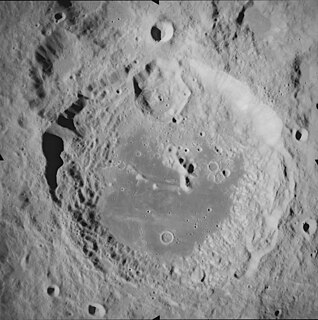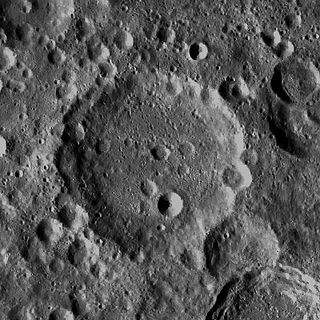
Aitken is a large lunar impact crater that lies on the far side of the Moon, named for Robert Grant Aitken, an American astronomer specializing in binary stellar systems. It is located to the southeast of the crater Heaviside, and north of the unusual formation Van de Graaff. Attached to the southwest rim is Vertregt. To the southeast is the smaller Bergstrand.

Anderson is a lunar impact crater that is located on the far side of the Moon. It is located to the northwest of the crater Sharonov, and the satellite crater Sharanov X is attached to the southeast rim of Anderson. To the northeast is the peculiar formation Buys-Ballot, and to the east-southeast lies the larger crater Spencer Jones.

Van de Graaff is a crater formation located on the far side of the Moon, on the northeast edge of Mare Ingenii.

Armiński is a small lunar impact crater that is located on the far side of the Moon, to the northeast of the large walled basin Gagarin. To the northwest of Armiński is the crater Beijerinck, and to the southeast lies Cyrano.

Babbage is an ancient lunar impact crater that is located near the northwest limb of the Moon, named after Charles Babbage. It is attached to the southeastern rim of the prominent crater Pythagoras. The crater remnant named South intrudes into the southeastern floor of Babbage.

Barnard is a lunar impact crater that is located near the eastern limb of the Moon. It is attached to the southeast rim of the large crater Humboldt, and Abel lies directly to the south. To the northeast is the crater Curie, while to the southeast is the Mare Australe.

Boyle is a lunar impact crater that is located in the southern hemisphere on the rugged far side of the Moon. It is adjacent to the larger crater Hess to the southeast, and lies about midway between the craters Alder to the north-northeast and Abbe to the south-southwest.

Dawson is a lunar impact crater that lies on the southern hemisphere on the far side of the Moon. It lies across a crater triplet: the southeast rim is intruding into the crater Alekhin; the northwest rim also intrudes into the larger satellite crater Dawson V, and the northeast rim is attached to the comparably sized Dawson D. To the south of this formation is the large crater Zeeman. West of Dawson is the crater Crommelin, and to the north lies Fizeau.

Chamberlin is a lunar impact crater that is located on the far side of the Moon, just past the southeastern limb. It lies to the southeast of the crater Jeans, and Moulton is attached to the southeastern rim of Chamberlin. This crater is located in a part of the lunar surface that has undergone resurfacing of crater interiors, producing dark-hued crater floors.

Biela is a lunar impact crater that is located in the rugged highlands of the southeastern Moon. It is named after Austrian astronomer Wilhelm von Biela. The crater lies to the east of Rosenberger, to the southeast of the Watt–Steinheil double crater.

De La Rue is the remnant of a lunar impact crater, or possibly several merged craters, creating a formation sometimes called a walled plain. It lies in the northeastern part of the Moon on the near side, and so appears foreshortened due to its location. This formation lies to the north-northwest of the prominent crater Endymion, just beyond the eastern extreme of Mare Frigoris. The crater Strabo intrudes into the northern part of De La Rue's northern rim, and the smaller Thales is attached to the northwestern part of the wall.

Casatus is a lunar impact crater that is located near the southern limb of the Moon. The north-northeast rim of the crater overlies a portion of the slightly larger crater Klaproth. Along the western rim, Casatus A intrudes somewhat into the interior, producing an inward-bowing rim. To the southeast of Casatus is Newton.

Miller is a lunar impact crater that lies amidst the rugged terrain in the southern part of the Moon. It is attached to the northern rim of the smaller crater Nasireddin, and the outer rampart of the latter reaches almost to the central peak formation at the midpoint of Miller's interior floor. Together with Huggins to the southwest and Orontius to the south-southwest, this foursome forms a chain of craters forming an arc that curves towards the north. The northwest rim of Miller in turn is attached to the satellite crater Miller C, forming the end of the arc. To the southeast lies Stöfler. The crater is named after British chemist William Allen Miller.

Dyson is a lunar impact crater, 63 kilometers in diameter, that lies on the far side of the Moon, past the northwest limb. It is located in the northern part of the surface, to the northwest of the crater Coulomb, and east of van't Hoff.

Comstock is a lunar impact crater that is located on the far side of the Moon. It lies to the northeast of the walled plain Fersman, and north of the crater Weyl.

Comrie is a lunar impact crater. It is located on the rugged far side of the Moon relative to the Earth, beyond the western limb. Nearby craters of note include Ohm to the south-southwest, Shternberg to the southwest, and Parenago to the northeast.

Dziewulski is a lunar impact crater on the far side of the Moon. It lies between the craters Edison to the north and Popov to the south. The outer rim of this crater has been considerably worn by impacts, particularly along the southwest quadrant where the satellite crater Dziewulski Q overlies the rim and the interior floor. The northern rim is also heavily disrupted, and several small crater lie along the southeast rim. The interior floor and surrounding terrain has been resurfaced.

Evershed is a lunar impact crater on the far side of the Moon, named after the English solar astronomer John Evershed. It is located to the northeast of the larger crater Cockcroft, and to the north of the smaller Van den Bergh.

Leeuwenhoek is a lunar impact crater that lies in the Moon's southern hemisphere, on the far side from the Earth. It is located to the east of the crater Birkeland and the unusual double crater Van de Graaff. To the northeast of Leeuwenhoek is Orlov and to the south is the large walled plain Leibnitz.

Nassau is a lunar impact crater on the Moon's far side. It abuts against the northeastern rim of the figure-8-shaped crater Van de Graaff. To the southeast of Nassau lies the crater Leeuwenhoek, and to the east is Orlov.





















